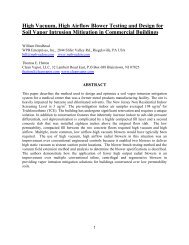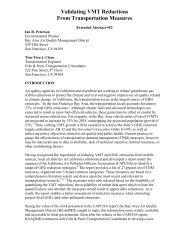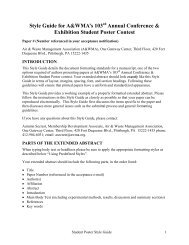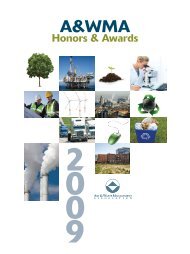Abstract Book
Abstract Book
Abstract Book
You also want an ePaper? Increase the reach of your titles
YUMPU automatically turns print PDFs into web optimized ePapers that Google loves.
that has been delegated authority to manage and regulate air emissions within its<br />
boundaries, is proposing a novel Non-Road Diesel PM Emission Reduction Initiative.<br />
The Initiative is focused on Tier 0 and Tier 1 high PM emitting engines and consists of<br />
simple but efficient regulatory requirements and an incentive fund. The Emission<br />
Regulation would require registration, machine labelling and fees for older Tier 0 and<br />
Tier 1 non-road diesel engines. Fees would be based on the magnitude of engine<br />
emissions and fee rates would increase over time, with the intent of accelerating the<br />
upgrade or replacement of older machines. Fees collected would contribute to an<br />
Incentive Fund that would be used to assist high-emitting engine owners and operators to<br />
reduce their emissions. Metro Vancouver has consulted on the Initiative with industry,<br />
engine owners and managers, equipment manufacturers, emission control suppliers,<br />
public health representatives and other interested parties for over a year and intends to<br />
develop regulatory language for adoption by its Board later in 2010. The regulation<br />
would be the first of its kind in Canada and could be a model for adoption in other<br />
jurisdictions.<br />
Healthy Canada by Design: Cross-Sector Innovation, Collaboration, and Evaluation<br />
in the Building of More Sustainable Communities (112)<br />
H. Swinkels; Fraser Health Authority, Surrey, BC, Canada<br />
A growing body of research has demonstrated that many land use development and<br />
transportation practices that improve air quality, reduce greenhouse gas emissions and<br />
minimize environmental damage are also associated with positive health impacts. These<br />
findings shed light on promising new levers to effectively mitigate potential water, food,<br />
energy, and environmental challenges while promoting public health.<br />
To move forward in integrating health promoting policies into land use and transport<br />
planning practice, a Canadian national coalition of health units, community planning<br />
organizations and NGOs came together in 2009 under the Canadian Partnership Against<br />
Cancer’s Coalitions Linking Action and Science for Prevention (CLASP) initiative. The<br />
project focuses on enhancing, field-testing and disseminating a range of tools and policies<br />
for improving the health and environmental impacts of new and existing urban<br />
communities in Canada. Tools currently under production include:<br />
-- A development checklist for planners with targets and an implementation plan;<br />
-- A software tool to evaluate the extent to which proposed developments will promote or<br />
hinder health;<br />
-- An analysis of consumer demand for more walkable residential developments;<br />
-- A synthesis of the latest Canadian research on health and the built environment;<br />
-- Evaluation of a training & technical assistance program to support partner health<br />
authorities in promoting healthy built environments;<br />
-- Results of the evaluation of grassroots initiatives to promote green, more walkable<br />
neighbourhoods.<br />
This presentation provides an overview of evolving approaches translating research on<br />
urban development and health into useable tools and policy supports.<br />
3D: Source-Receptor Modelling<br />
24












